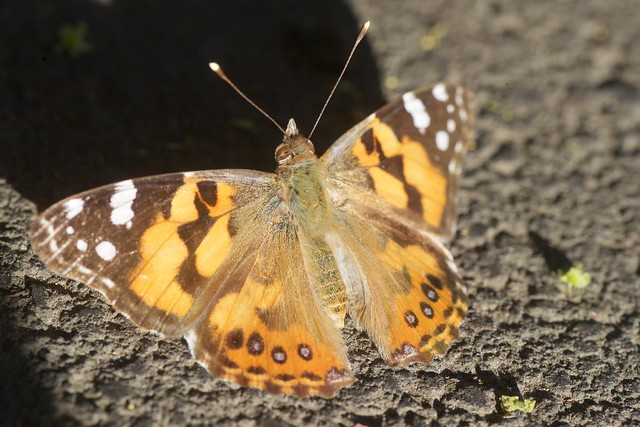RECENT ARTICLES
- CEBRA: An optimised and standardised sampling protocol for BioBlitz
- Stop it people, the plural of anecdote IS data!
- That's no pollinator, that's a flower visitor
- Add a scale to your macro photos
- What to photograph when counting the wild
- Imagine counting the wild on EVERY street in a city!
- My wild counting workflow
- A butterfly flew through
- Why iNaturalist observations without photos can be research grade
- Why you shouldn’t use a spreadsheet for data entry
- All articles ...
My first painted lady: Australia is just one El Niño away
When the natural environment changes, there are always new species waiting to take advantage of the changed habitats. Keep an look out for new arrivals in your neighbourhood.
written Oct 20, 2015 • by Jon Sullivan • Category: Wild Changes

The strong El Niño westerly winds this month have brought Australian painted ladies (Vanessa kershawi) to Christchurch, New Zealand. I’d never seen these butterflies before (and I count every butterfly I see). Yet, this month I’ve seen two of them.


New Zealand’s environment has changed hugely since human arrival, especially in the drier lowlands. This has made a lot of open grassland and scrubland habitat better suited to Australian species than New Zealand’s endemic forest specialists. Because of this, there’s been a constant trickle of Australian native species finding their way across the Tasman Sea and establishing in New Zealand. Among NZ birds, the recent Australian arrivals include the silvereye, spur-winged plover, black swan, welcome swallow, and probably the pukeko.
The warmer conditions and stronger westerly winds predicted from global warming must be likely to accelerate this trend. It’s likely only a matter of time before vagrant Australian species arrive in enough numbers at the right places and times to permanently establish.
One of these is likely the Australian painted lady butterfly. It’s a not uncommon vagrant in New Zealand, especially in the west, often blown across the Tasman in strong winds. To-date, there are no records of it surviving a New Zealand winter here, but that may only be a matter of time and rising greenhouse gases.
Back in 1968, entomologist Eric Pritchard observed an Australian painted lady laying eggs on what he called Japanese cudweed in St. Heliers Bay, Auckland. He carefully collected the leaves with the eggs, and they hatched into caterpillars. He successfully fed them on Japanese cudweed. Four successfully made it through to pupae and emerged as butterflies 46–49 days after the eggs were laid. Eric concluded at the time that “Although Vanessa kershawi has found suitable host plants in Auckland it does not yet seem to persist here.” He reported his findings in the journal NZ Entomologist.
I expect to see more painted ladies in years ahead.